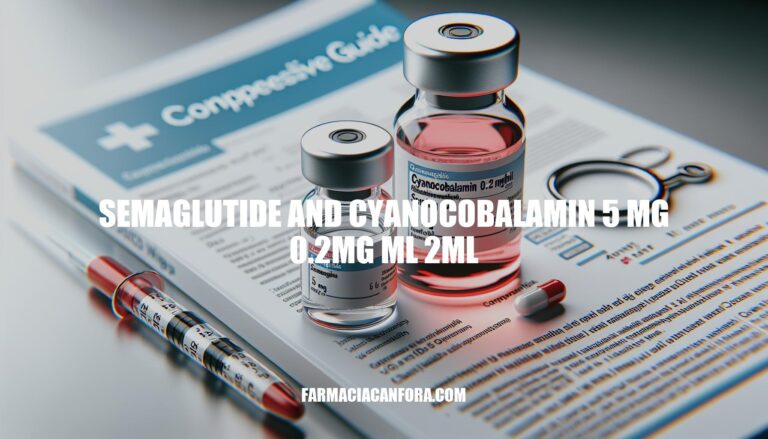Semaglutide and cyanocobalamin (5 mg/0.2 mg per ml, 2 ml) is a combination medication used primarily for managing type 2 diabetes and obesity. Semaglutide, a GLP-1 receptor agonist, helps regulate blood sugar levels and reduce appetite, while cyanocobalamin (vitamin B12) supports energy levels and nervous system health. This combination aims to improve glycemic control and promote weight loss, offering a comprehensive approach to managing these conditions.
Mechanism of Action
Semaglutide is a GLP-1 receptor agonist that helps control blood sugar levels by stimulating insulin release, reducing glucagon production, and slowing gastric emptying. Cyanocobalamin (vitamin B12) supports metabolism and energy production. When combined, semaglutide’s potential to cause B12 deficiency due to slowed gastric emptying is mitigated by the cyanocobalamin, ensuring adequate B12 levels. This combination enhances weight loss and glycemic control while preventing B12 deficiency.
Clinical Applications
Here are the clinical uses of semaglutide and cyanocobalamin:
Semaglutide
- Type 2 Diabetes: Semaglutide is used to improve glycemic control in adults with type 2 diabetes. It works by mimicking the GLP-1 hormone, which increases insulin release, decreases glucagon production, and slows gastric emptying.
- Weight Management: It is also prescribed for weight loss in individuals with obesity or overweight with at least one weight-related condition (e.g., hypertension, type 2 diabetes). Semaglutide helps reduce appetite and calorie intake.
- Cardiovascular Risk Reduction: For patients with type 2 diabetes and established cardiovascular disease, semaglutide can reduce the risk of major cardiovascular events such as heart attack or stroke.
Cyanocobalamin (Vitamin B12)
- Vitamin B12 Deficiency: Cyanocobalamin is used to treat and prevent vitamin B12 deficiency, which can lead to conditions like pernicious anemia, megaloblastic anemia, and neurological disorders.
- Support for Semaglutide Therapy: When combined with semaglutide, cyanocobalamin can help mitigate the risk of B12 deficiency due to the gastrointestinal effects of semaglutide, which may impair B12 absorption.
These medications are often administered together to enhance therapeutic effects and prevent deficiencies.
Dosage and Administration
Semaglutide Dosage and Administration
For Type 2 Diabetes:
-
Oral Tablets:
- Initial dose: 3 mg orally once a day for 30 days.
- Maintenance dose: 7 to 14 mg orally once a day.
- Maximum dose: 14 mg/day.
-
Subcutaneous Injection:
- Initial dose: 0.25 mg subcutaneously once a week for 4 weeks.
- Maintenance dose: 0.5 to 1 mg subcutaneously once a week.
- Maximum dose: 1 mg/week.
For Weight Loss:
- Subcutaneous Injection:
- Initial dose: 0.25 mg once weekly for 4 weeks.
- Maintenance dose: 0.5 mg once weekly for 4 weeks.
- Maximum dose: 2.4 mg once weekly.
Cyanocobalamin (Vitamin B12) Dosage and Administration
For Vitamin B12 Deficiency:
- Intramuscular Injection:
- Typical dose: 1000 micrograms (mcg) per injection.
- Frequency: Usually administered once a week initially, then monthly for maintenance.
- Recommended injection site: Deltoid muscle.
Please consult with a healthcare provider for personalized medical advice and adjustments based on individual health conditions and responses to treatment.
Benefits
Semaglutide:
- Weight Loss: Clinical trials show significant weight loss in individuals with obesity or overweight, with an average reduction of 15.2% of body weight over 104 weeks.
- Glycemic Control: Improves blood sugar levels by increasing insulin release, reducing glucagon, and slowing gastric emptying.
- Cardiovascular Benefits: Reduces the risk of major cardiovascular events like heart attack and stroke in type 2 diabetes patients.
Cyanocobalamin (Vitamin B12):
- Prevents B12 Deficiency: Essential for preventing B12 deficiency, which can be a side effect of semaglutide due to its impact on gastric emptying and stomach acid production.
- Boosts Metabolism and Energy: Supports metabolism and energy levels, potentially enhancing the weight loss effects of semaglutide.
Combining these two can enhance the therapeutic effects of semaglutide, particularly in weight loss and glycemic control, while mitigating the risk of B12 deficiency.
Side Effects
Sure, here are the potential side effects of semaglutide and cyanocobalamin:
Semaglutide
- Nausea: Common, especially at the start of treatment.
- Diarrhea: Can occur as the body adjusts.
- Vomiting: Often related to gastrointestinal discomfort.
- Abdominal pain: May be experienced by some patients.
- Constipation: Another gastrointestinal side effect.
- Decreased appetite: Can lead to weight loss.
- Fatigue: Some patients report feeling tired.
- Dizziness: Occasionally reported.
Cyanocobalamin (Vitamin B12)
- Injection site reactions: Pain, redness, or swelling at the injection site.
- Diarrhea: Possible gastrointestinal reaction.
- Itching or rash: Allergic reactions can occur.
- Headache: Some patients may experience headaches.
- Dizziness: Similar to semaglutide, dizziness can occur.
Semaglutide and Cyanocobalamin: A Combination Medication for Type 2 Diabetes and Obesity
Semaglutide and cyanocobalamin (5 mg/0.2 mg per ml, 2 ml) is a combination medication used to manage type 2 diabetes and obesity.
Semaglutide helps regulate blood sugar levels and reduce appetite, while cyanocobalamin supports energy levels and nervous system health. This combination aims to improve glycemic control and promote weight loss.
How it Works
Semaglutide works by stimulating insulin release, reducing glucagon production, and slowing gastric emptying, while cyanocobalamin mitigates the risk of B12 deficiency due to semaglutide’s gastrointestinal effects.
The medication is often administered together to enhance therapeutic effects and prevent deficiencies. Clinical uses include type 2 diabetes, weight management, and cardiovascular risk reduction.
Semaglutide Dosage
Semaglutide dosage varies depending on the condition being treated, while cyanocobalamin is typically administered intramuscularly for vitamin B12 deficiency.
Potential Side Effects
Potential side effects of semaglutide include nausea, diarrhea, vomiting, abdominal pain, constipation, decreased appetite, fatigue, and dizziness, while cyanocobalamin may cause injection site reactions, diarrhea, itching or rash, headache, and dizziness.
Combining these two medications can enhance therapeutic effects, particularly in weight loss and glycemic control, while mitigating the risk of B12 deficiency.


